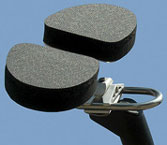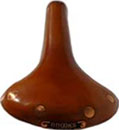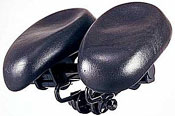![]()
![]()
|
| Pity
the poor bicycle seat. Few products in the history of sports have taken
such a bum rap. Prostate problems. Numbness. Boils. Infections. Chafing.
Even impotency! You name the malady and it’s likely been blamed on
the pedaler’s perch, the cyclist’s throne, the bike saddle. Some criticism is justified because any reasonable person might assume that if you buy a good bike, you get a good seat. In fact, you might not even give the seat a second thought and start logging big miles immediately. And, if you develop pain and discomfort, you might cling to the notion that it can’t be the seat and simply keep riding, figuring that if you pedal enough, the aches and pains will disappear. If you’re lucky, that might happen. But, it could also be a bad mistake — the type of oversight that could cause many of the problems mentioned above. Unfortunately, bike seats are not that simple. A seat is a bit like a pair of shoes. The same way you’d buy a certain sneaker for a particular foot and sport, you must purchase a saddle that fits your body and your style of riding. What’s more, and this is absolutely crucial for problem-free cycling, the seat must be expertly adjusted to fit your body (see sidebar below, or read my step-by-step bicycle fitting guide). Often, a perfectly adequate seat will feel awful and cause trouble simply because it’s not set correctly. |
||||
The
Science of bicycle seats This is
because, a fast-riding position on a bike shifts you forward placing
more weight on the hands and feet and reducing a lot of the weight on
the seat. Also, as you pedal more vigorously, you spin faster and you
don’t want interference from the sides of the seat. These factors
make a wide, heavily padded saddle ideal to support your weight and
provide cushioning. If a saddle
is right for your body, its rear will support your sit bones (the ischial
tuberosities - those two protrusions that bug you when you sit on a
hard bench). These bones will form dents in certain types of seats.
If the seat is correct for your anatomy, the depressions will be centered
on the pads of the seat on either side. Some seats feature soft foam or gel in the nose and softened bases beneath to reduce the stiffness. These are usually called Gel seats. The important thing to know is that if you find the seat’s nose a problem, there are models designed to remove the intrusion. Try a few until you find the model that works for you. |
Brooks Selle San Marco Selle Italia Selle Royal Avocet Trico Sports Serfas Terry Bicycles seats Modern Marvels Try one of these seats if you’re unhappy with conventional models: BiSaddle The Seat Derri-Air Saddles Spiderflex Saddle Nexride Saddles The Moon Saddle Carbon Comfort Saddle ISM Seat Spongy Wonder (below) 
The Spongy Wonder MK9 Real Seat (below) 
The Real Seat is a lawn chair for your bike (click pic to enlarge). |
It
Came From Outer Space | ||
Because the
saddle top is suspended on rails beneath the seat, there’s give in
the seat top that helps suck up bumps, and air can pass beneath the seat
helping to cool you a little. Plus, the long top allows you to scoot forward
or back to shift the pedaling position and to adjust body weight when
needed to control the bike or simply for a change to rest tired butt muscles.
What’s amazing is that all these features are available in something
that can weigh less than 200 grams, last 10,000 miles and cost less than
a good meal. | ||||
| Now
that you’ve got your cycling shorts, you need a couple of riding
tips to protect your body. Don’t just head out and mindlessly pedal
along. That concentrates the pressure on the contact points, the handlebars,
pedals and seat. The key to comfort is moving around regularly to shift
the pressure (this goes for your hands and feet, too). Standing occasionally
such as when you’re climbing, relieves the pressure on the seat and
gets a whole new set of muscles working. And any time you’re rolling over bumpy terrain, take the weight off the saddle by lifting your body slightly with your knees so that you’re in a jockey’s position on the bike. In this riding position, the seat won’t be able to slam into your groin or transfer impacts from the wheels if your run into ruts, rocks and holes. |
|
|||
| Seat
Types There are hundreds of seats to select from but they fall into seven broad categories. Keep in mind that there’s crossover between categories and types. For example, Gel seats are available in performance, mountain bike, wide/cushion styles and others. The important thing to understand is that there’s no reason you can’t use any seat for any purpose if it feels good to you. | ||||
| Seat type | Ideal User | Features |
Racing |
You ride for fitness and training wearing cycling clothing and maintaining a high pedal rpm and fairly rapid pace. You like to go long, ride centuries and sometimes ride aggressively on and/or off road. You sit in a racey position with your handlebars lower than your seat. | Light (sometimes have titanium or carbon rails); minimal padding; narrow shape; pretty stiff top. |
Mountain
Bike |
You ride a lot off road on challenging terrain where your body and bike take a beating. You move around on the seat a lot to apply body English on technical sections, for example sliding way off the back of the seat to safely descend a steep slope or perching on the saddle nose to keep the front wheel down on the steeps. | Fairly narrow shape; medium padding to soften blows; light; shaped rear section to ease moving rearward; downward sloped nose for moving forward further; sometimes reinforced on the areas that touch down when you crash. A few models designed for aggressive off-road riding, feature extra length for even more fore/aft body position adjustments when jamming. |
Gel |
You find that most normal-padded seats irritate your groin or your sit bones. You suffer from occasional numbness on longer rides. | Great cushion through the use of gel, a shock absorbing material that also molds to you for a custom fit; gel adds weight but there are light and heavier gel seats; often slightly wider throughout; flexible top; may feature bumps to support the sit bones. There are many types of gel seats. |
Cutaway |
You’ve tried lots of seats and you can’t find anything that eliminates pain, tingling, numbness and irritation. Especially bothersome is the saddle nose that digs into your groin and soft tissue causing pain and suffering even on short rides. | Material is removed from the saddle top to eliminate pressure points; some have actual cutouts (holes or slots) in the top; various models are available: performance, mountain bike, gel); high-tech look. |
Wide/Cushion |
You ride in an upright position on a bike where the handlebars are as high or higher than the seat, which puts a lot of your weight on the seat. You don’t pedal very fast or ride very aggressively. You don’t wear cycling clothing. | Wide throughout but especially on the back; lots of padding; sometimes springs are built into the underside of the seat; heaviest of all seat types. |
All-Leather |
You’re a traditionalist who likes natural bike products and wants a classy looking bicycle. You enjoy longer rides and keep up a fair pace and you want a seat that will break in to fit your body over the miles. You don’t mind taking extra steps to maintain your products but you like them to last a long time. | Beautiful; absorbs body heat keeping you cooler; medium weight; breaks in to you over time. Note that leather can be susceptible to water damage (carry a plastic cover and use it whenever it rains) and some saddles may require a break-in period before they becomes comfortable. |
Alternative The Easy Seat |
You’ve had prostate surgery or have injuries to the groin area that make it very painful to sit on regular bicycle seats and you’ve tried them all. You ride in an upright position with handlebars higher than the seat and you don’t pedal fast or ride aggressively. You just want to ride again for fun and exercise and are willing to experiment to find a seat, any seat that won’t hurt you. | Most
unique
designs of any seat category; often adjustable or articulated (parts of
the seat move with the body); some are expensive; heavier than standard
seats; don’t always attach easily to the bike. Sources (more above): BiSaddle Spongy Wonder The Seat Nexride Saddles The Moon Saddle Derri-Air Saddles Spiderflex Saddle |